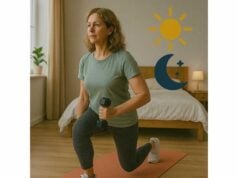
Heart rate variability (HRV) is one of the clearest windows into how well your nervous system adapts to daily stress. It captures the tiny differences between successive heartbeats—changes that reflect the tug-of-war between the calming parasympathetic branch and the mobilizing sympathetic branch of your autonomic nervous system. In midlife and beyond, HRV trends tell you if your recovery practices are working, whether training is appropriately dosed, and when illness or overreach may be brewing. This guide demystifies the common metrics (RMSSD, SDNN, frequency bands), shows you how to measure HRV reliably at home, and explains what to do with dips and rises week to week. We will pair practical tactics—sleep, breathwork, hydration, aerobic base—with red flags that deserve medical follow-up. For a broader foundation on how sleep and stress skills support healthy aging, visit our concise hub on sleep, stress, and recovery strategies.
Table of Contents
- What HRV Measures: SDNN, RMSSD, and Frequency Domains
- Factors That Influence HRV with Aging
- How and When to Measure HRV for Reliable Trends
- Raising HRV: Sleep, Breathwork, Hydration, and Aerobic Base
- Interpreting Day to Day Dips vs Long Term Trends
- Red Flags: When Low HRV Warrants Medical Attention
- Using HRV to Adjust Training and Bedtime Routines
What HRV Measures: SDNN, RMSSD, and Frequency Domains
HRV quantifies the beat-to-beat variability in your heart’s rhythm. Instead of averaging heart rate over a minute, HRV looks at the intervals between R-waves on the ECG (or their analogs from optical sensors). The more flexible your autonomic system, the more those intervals vary in healthy patterns—especially with the breath.
Time-domain measures
- RMSSD (Root Mean Square of Successive Differences): Reflects short-term, high-frequency variability driven largely by the parasympathetic (vagal) system. It is robust against slow drifts and motion artifacts and works well from short recordings (1–5 minutes), which is why many wearables use it for “morning readiness.” Because RMSSD is skewed, devices often report lnRMSSD (natural log) to stabilize the scale.
- SDNN (Standard Deviation of Normal-to-Normal intervals): Captures overall variability across the recording. On a full 24-hour ECG, SDNN reflects combined sympathetic and parasympathetic influences. On ultra-short (1–5 minute) recordings, SDNN can track with RMSSD but is more sensitive to recording length and artifacts.
Frequency-domain measures
Using spectral analysis, HRV is decomposed into bands:
- HF (High Frequency, ~0.15–0.40 Hz): Mirrors respiratory sinus arrhythmia—the waxing and waning of heart rate with the breath. It is a marker of vagal activity.
- LF (Low Frequency, ~0.04–0.15 Hz): A blend of sympathetic and parasympathetic activity influenced by baroreflexes; it is not a pure “sympathetic index.”
- VLF (Very Low Frequency, ~0.003–0.04 Hz): Reflects slower regulatory processes (thermoregulation, renin–angiotensin, circadian effects) and generally requires longer recordings to interpret.
Nonlinear measures
Metrics like Poincaré plot parameters (SD1/SD2) and entropy indices describe the complexity of your heart rhythm. In clinical research they can add nuance, but for home use they rarely change decisions beyond time-domain trends.
What “good” looks like
Absolute HRV values vary widely by age, sex, fitness, and genetics. A healthy fifty-something may have a lower absolute RMSSD than a twenty-something but still show excellent day-to-day stability, a gentle seasonal rise with consistent training and sleep, and predictable dips after strain or illness. Your baseline and trend matter more than someone else’s number. The right question is: given my age and context, is my HRV stable, rising slowly, or persistently suppressed?
Factors That Influence HRV with Aging
HRV tends to decline gradually with age, but the slope is not fixed. Much of what we call “aging” in HRV reflects behavior and health status more than the calendar alone.
Physiology and hormones
- Autonomic balance shifts: Baseline sympathetic tone often creeps up with age, while baroreflex sensitivity and vagal responsiveness diminish.
- Vascular stiffness: Arteries become less compliant, dampening the heart–vascular feedback loop that drives variability.
- Endocrine transitions: Menopause and age-related testosterone changes can alter sleep, thermoregulation, and autonomic balance, indirectly suppressing HRV.
Sleep and circadian timing
Fragmented sleep, irregular bedtimes, late evening light, and noisy sleep environments erode nocturnal vagal tone. Stabilizing anchors—fixed wake time, morning light, and dim evenings—protect HRV by improving sleep consolidation. For a step-by-step reset, see our guide to resetting your body clock.
Lifestyle load
High training strain without adequate rest, persistent psychosocial stress, alcohol in the late evening, and late, heavy meals raise nighttime heart rate and reduce HRV. Dehydration is an underrated drag; even mild deficits increase heart rate variability’s noise and can depress values.
Health conditions and medications
Obstructive sleep apnea, diabetes, metabolic syndrome, chronic pain, and inflammatory disorders lower HRV on average. Beta-blockers, some antidepressants, and decongestants can alter autonomic tone. If your HRV dropped after a medication change, discuss it with your clinician rather than chasing the number with harder training.
Genetics and sex differences
There is wide individual spread. Some people sit “naturally” higher or lower. Sex differences exist across the lifespan, but behavior (sleep, training, alcohol timing) and cardiorespiratory fitness remain strong modifiable levers for both men and women.
Bottom line: the modifiable drivers—sleep regularity, aerobic fitness, stress skills, hydration, evening alcohol and meal timing—explain a surprising share of HRV variance in midlife. Improve those first, then ask whether anything medical is holding HRV down.
How and When to Measure HRV for Reliable Trends
HRV is exquisitely context-sensitive. To interpret it, standardize timing, posture, and method.
Best-practice timing
- Morning, right after waking is the gold standard for at-home trends. Measure before caffeine, emails, or exercise. If you prefer nocturnal HRV from a wearable, rely on its same-window nightly estimate and avoid mixing methods.
- Posture control: Use the same posture daily—supine or seated. Seated readings (90° hip angle, feet flat) are slightly more sympathetic and can reveal stress reactivity; supine is calmer and often less noisy. Pick one and stick with it.
Recording length and metrics
- For time-domain morning readings, 60–120 seconds can work, but 3–5 minutes is better when available. Use lnRMSSD as your primary marker; track resting heart rate alongside it.
- For frequency-domain analysis, longer artifact-free recordings are needed; for everyday decisions, time-domain trends generally suffice.
Hardware and apps
- ECG chest straps offer excellent signal quality. Many modern PPG wearables do well at night but can miss beats during movement or cold hands.
- Avoid changing devices mid-project. If you must, run a two-week overlap and scale expectations.
Artifact control
- Skip readings during acute illness, fever, or after alcohol-heavy evenings; log the context and let the baseline recover before you compare.
- Breathe naturally. Paced breathing can inflate HRV acutely; it is ideal for training your nervous system, not for measuring your baseline.
Data handling
- Use a 7-day rolling average as your baseline. Flag meaningful deviations as drops ≥6–8% below baseline for two or more days.
- Pair HRV with subjective markers (sleep quality, mood, soreness) and training load; the combination is far more informative than a single metric.
If you want a focused checklist on which wearable numbers help versus distract, see our practical overview of wearables worth watching.
Raising HRV: Sleep, Breathwork, Hydration, and Aerobic Base
You cannot force HRV up overnight, but you can create conditions that lift your baseline over weeks.
Prioritize sleep regularity
- Fix your wake time seven days a week, get morning outdoor light, and protect a 3–4 hour gap between dinner and bedtime. These steps improve sleep continuity and deepen slow-wave sleep, where vagal tone is strong. For dinner timing that supports sleep, skim our guide to chrononutrition.
Use breathwork to train vagal tone
- Paced breathing at 4.5–6.5 breaths per minute (about in 4–5 seconds, out 5–6 seconds) increases respiratory sinus arrhythmia and can lift HRV acutely. A 5–10 minute session in the evening or before stressful meetings is an easy daily practice. Techniques like box breathing and resonance breathing are simple, portable, and safe for most people. For detailed pacing and progression, see breathwork basics.
Build an aerobic base
- Regular Zone-2 cardio (easy, conversational pace) for 150–240 minutes per week is one of the most reliable ways to raise HRV over months. It enhances mitochondrial efficiency and baroreflex function while reducing resting heart rate—changes that raise variability.
Strength train smart
- Two to three full-body sessions per week support glucose control, bone density, and injury resilience. Keep late-evening heavy lifting rare; finish strenuous sessions 3+ hours before bed and cool down well. If your schedule pushes you late, swap to technique work or mobility to protect sleep.
Hydrate and manage electrolytes
- Even 1–2% dehydration can nudge heart rate up and HRV down. Front-load fluids during the day and taper in the last two hours before bed. In hot weather or during long training, add sodium per sweat losses to maintain plasma volume.
Alcohol, caffeine, and light
- Limit alcohol on weeknights and finish drinks ≥3 hours before bed; set a caffeine cutoff 8–10 hours before bedtime (10–12 hours if sensitive). Keep evening light dim and warm to protect melatonin and nocturnal HRV. For a full evening playbook, see timing rules for caffeine, alcohol, and late meals.
Think in weeks and seasons, not days. HRV climbs slowly with better sleep and aerobic fitness, drops briefly with viruses or travel, and trends upward again if you stay consistent.
Interpreting Day to Day Dips vs Long Term Trends
Some HRV noise is useful—it reflects adaptation. The skill is distinguishing a productive dip from a problematic slide.
Normal, adaptive dips
- After high strain: A 1–3 day drop following a hard race or heavy blocks is expected. If sleep is solid and mood is good, recover with easy movement, extra protein and carbs, and a bit more sleep. HRV should rebound toward baseline within 72 hours.
- During travel: Time zones, long flights, and hotel sleep push HRV down transiently. Anchor light exposure and meals to local time and avoid late alcohol; values typically recover within 3–5 days.
Warning patterns
- Persistent suppression: A >8–10% drop below your 7-day baseline lasting 4–7 days suggests accumulating stress, under-recovery, illness onset, or sleep disruption.
- Divergence: Resting heart rate drifts up while HRV trends down for a week; mood and sleep worsen. This often means load is too dense or bedtime routine is failing.
- Flat-lined low HRV: Chronically low variability with minimal day-to-day change can reflect poor sleep, heavy alcohol intake, depression, or medical issues that need attention.
Context checks before acting
- Sleep duration and continuity in the last week.
- Alcohol timing and dose, especially within 3 hours of bed.
- Dinner timing and composition.
- Training density: Are high-strain days stacked without true easy days?
- Psychosocial load: conflict, deadlines, caregiving spikes.
- Illness cues: scratchy throat, heaviness, elevated morning temperature.
When in doubt, prioritize sleep, light anchors, and easy aerobic sessions for 48–72 hours. If HRV rebounds and you feel better, resume your plan. If not, reduce load for the week and consider whether a medical issue (e.g., infection, untreated sleep apnea) is at play. To strengthen stress skills that buffer dips, see our guide to stress resilience.
Red Flags: When Low HRV Warrants Medical Attention
HRV is not a diagnostic test, but it can point to issues that deserve professional evaluation—especially when combined with symptoms.
Seek medical advice if you notice:
- Sustained HRV suppression and elevated resting heart rate for >2 weeks without clear training or lifestyle causes.
- New palpitations, dizziness, chest discomfort, fainting, or shortness of breath, regardless of HRV.
- Marked sleep disruption with loud snoring, witnessed apneas, or choking arousals. Untreated obstructive sleep apnea commonly lowers HRV and raises cardiovascular risk; start with a validated sleep questionnaire and discuss testing basics (overview here: signs and testing for sleep apnea).
- Fever, unexplained weight loss, or persistent fatigue alongside HRV decline.
- Medication changes (decongestants, stimulants, beta-blockers, some antidepressants) temporally linked to HRV shifts plus symptoms.
Special populations
- Cardiovascular disease or diabetes: Use HRV trends only in partnership with your clinician; low HRV may reflect autonomic neuropathy or other complications that require specific management.
- Eating disorders or significant weight loss: HRV can be low during relative energy deficiency; prioritize medical and nutritional care before using HRV to guide training.
What your clinician may consider
- Resting ECG, ambulatory monitoring, and labs (thyroid, iron studies, inflammation).
- Screening and treatment for sleep apnea.
- Medication review and safer alternatives when appropriate.
Treat HRV as a conversation starter, not a verdict. If the number points to trouble and your body agrees, get it checked.
Using HRV to Adjust Training and Bedtime Routines
HRV shines when it shapes decisions you can act on today while protecting progress for the season.
Daily decision framework (morning reading)
- Green (≥ baseline): Proceed with planned training. Keep nutrition and hydration on point.
- Yellow (4–8% below baseline or poor sleep): Run the session but dial volume or intensity down 10–20%. Emphasize technique, extend warm-up, and lock in an earlier, lighter dinner.
- Red (≥8–10% below baseline with fatigue, soreness, or mood drop): Swap to Zone-2 aerobic work or a walk, shorten the session, and add 5–10 minutes of breathwork. Push high-strain work to later in the week.
Weekly planning
- Cluster high-strain days when HRV is trending up or stable. Follow 1–2 hard days with a true easy day (not just “less hard”).
- End heavy training blocks with a down week (volume −20–30%, intensity −10–15%). Well-timed deloads protect HRV and make the next block more productive.
Bedtime routine adjustments guided by HRV
- If nocturnal HRV is drifting down, audit the last 3 hours before bed: bright light, stimulating content, late heavy meals, alcohol, or late caffeine are usual suspects. Replace them with:
- Dim, warm light and minimal screens.
- A 10-minute wind-down (stretching plus exhale-biased breathing).
- Cool bedroom (often 17–19 °C), breathable bedding.
- Earlier, lighter dinner with fluids tapered to reduce awakenings.
Sickness or travel
- During illness, expect HRV to drop. Shift to maintenance: easy movement, extra sleep, fluids, and nutrition. Resume intensity only after symptoms and HRV stabilize.
- With travel, set anchors on day one: morning local light, regular meals, and early alcohol cutoff. HRV usually normalizes in 3–5 days.
Mindset
- Do not chase single numbers. Use HRV as one voice in a committee that includes sleep, mood, soreness, performance feel, and resting heart rate. When the committee agrees, act decisively. When it argues, choose the most recoverable option.
References
- Heart rate variability: standards of measurement, physiological interpretation and clinical use (1996) (Guideline)
- An Overview of Heart Rate Variability Metrics and Norms (2017) (Review)
- A healthy heart is not a metronome: an integrative review of the heart’s anatomy and heart rate variability (2009) (Review)
- Heart rate variability: A biomarker of cardiac autonomic function from bench to bedside (2018) (Review)
- HRV biofeedback: Mechanisms and clinical applications (2017) (Review)
Disclaimer
This article is educational and is not a substitute for professional medical advice, diagnosis, or treatment. HRV trends can be influenced by illness, medications, and underlying conditions. Consult a qualified clinician if you have persistent HRV suppression, cardiovascular symptoms, diabetes or neuropathy, suspected sleep apnea, or if you plan major changes to training or medications based on HRV. If sleep or fatigue problems persist for more than a few weeks, seek clinical evaluation.
If this guide was helpful, please consider sharing it on Facebook, X (formerly Twitter), or any platform you prefer, and follow us for future updates. Your support helps us continue creating clear, practical resources on recovery and healthy aging.










